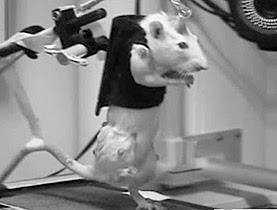So, I raced yesterday: the Ontario Masters Indoor Championships. I was entered in the 3000m - and hoped, like last year, to take home the Crown...
My coach Matt Loiselle (click for Matt's coaching page "The Good Times Running") and I had planned out the perfect race strategy - much like Pre (see the clip above - start it at around 7:10 [and pardon the stupid Spanish sub titles], where Pre, driving and talking with the (now) American running legend Frank Shorter, lays out the race strategy he planned to implement to set the World Record for the 3 mile: "64 secs - boom; 1:28 - boom..."). You get the point - I too had planned on a specific pace: 40 sec per 200, 39 for the last = 9:59. In fact, for me, winning the race yesterday took a back seat to the goal of a sub 10min performance.
However, as the kids say, "fail". Ya, I won the race (in 10:13), but not the goal I had set.
For although I put in the work physically, I guess I am still a work in progress on the mental toughness. Unlike a longer race - like any of the Ironman's I have raced, where if you drift off for a few secs and lose focus, not really a big deal - in a 3000m race, if you lose focus and thus precious seconds, you are dead in the water. And I ain't no Pre (as if).
The race started out perfectly; I was relaxed and in the zone. I went thru 1 km in exactly 3:20 - perfect; 1200 in 4:01 - "pretty damned to close to goal pace, no worries, make it up on the bell lap"; cruising thru 1400m, I noticed I was now 2 seconds off pace. "Uh oh". 1600 - 3 seconds off goal pacing..."uh oh" big time.
Kurt Vonnegut once famously wrote "And so it goes".
And for me yesterday, so it went - slowly, inexorably, obviously, in plain view as I watched the race clock tick away each lap - downhill. What was to be a goal I have not yet achieved - sub 10 for 3km - was again, damn it, not to be.
I finished the race with the crushing knowledge that I had, somewhere after after 1400m, drifted mentally, and in losing my focus and the toughness to "hurt", had failed to run the race I had not only trained for, but was more than capable of running.
It was not the fact I had not run sub 10 min per se that pissed me off (ok, that did piss me off royally); rather, it was the knowledge - only gained upon post race reflection, because when in the moment you don't see the reality of time - that I had simply quit on myself.
I knew the race goal I had set would hurt - running on the razor's edge at red line pace is not fun - and yet with full knowledge and awareness, at some point I still unconsciously backed away from the place all runners have to go to achieve (their own personal) greatness: "the dark place".
Nietzsche wrote in his famous work "Beyond Good and Evil", referencing the Superman, "when you look long into the abyss, the abyss looks long into you". I didn't do that yesterday; I just have to re-learn how to look in to that abyss, a place I have only been on a few, rare occasions.
Because now I see this possibility not as a place or thing to fear, but as an opportunity, as Nietzsche wrote, "to get faster, stronger, to suffer". The abyss is a place I have to go - because I can.
So today, instead of wallowing in self pity, I headed out the door and ran - ran to exorcise the demons of self-doubt and anger at what I initially saw as a failure. And I had a good run - a damned good run.
And rather than post the link to Beck's song, "I'm a Loser, Baby (So Why Don't You Kill Me)", which I initially thought was the perfect metaphor for my race yesterday, let's try this approach instead - a cool Nike commercial using the poetry of Langston Hughes:
run fast
Johnny Boy


















